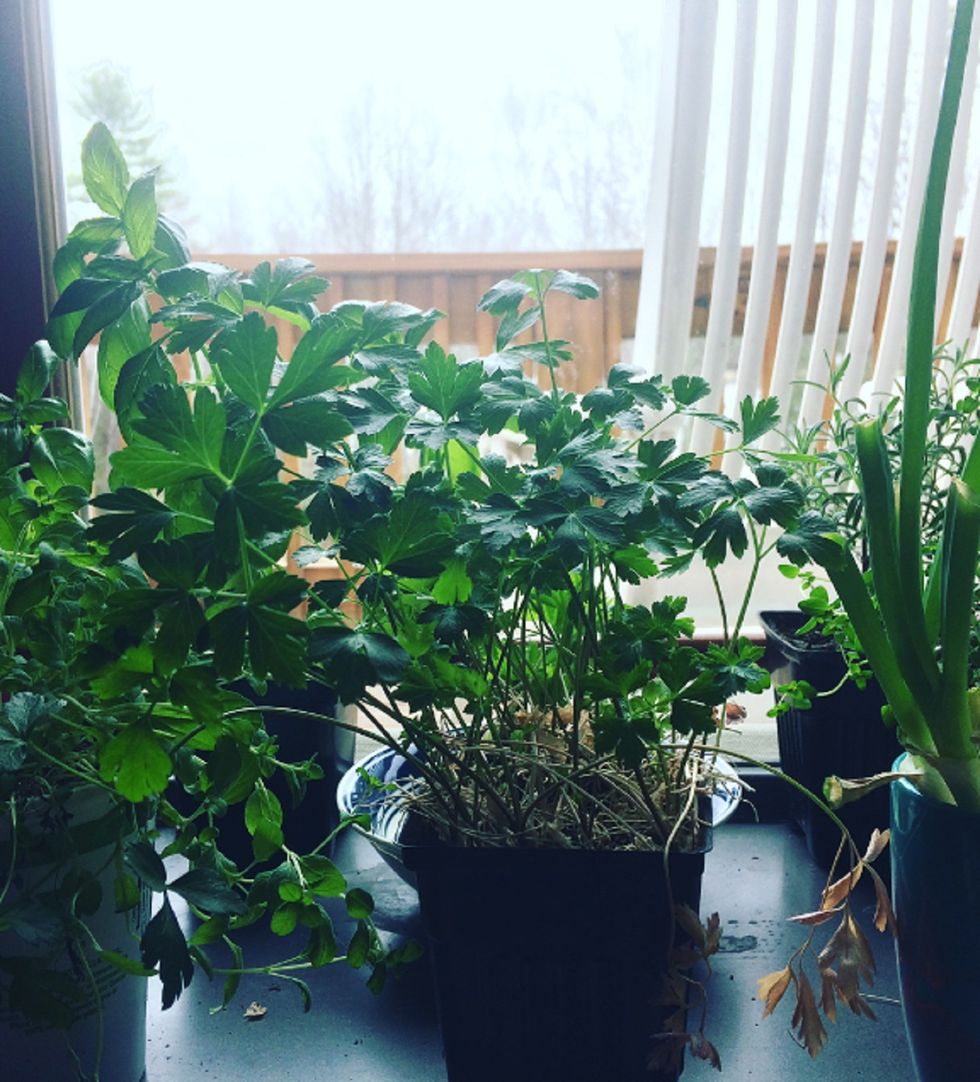Well, you live in an apartment.
Does this mean you can’t have fresh vegetables and herbs?
No, it doesn’t, creating a garden just takes a little finesse when you are working with smaller spaces and sometimes limited light.
Plants have a wonderful way of connecting us to nature as well as clearing the air. Did you know that the air inside your living space can be more polluted than anything outside? We tend to keep our homes shut up; with winter cold and summer heat, we create an artificial living environment that has made us unable to adapt to the changing temperatures outside.
This inside air becomes stale and full of contaminants; for example, germs from the cold season, dust, and allergens from pets. According to the EPA, there is also VOC’s (Volatile Organic Compounds) from paint and cleaners, even your carpet emits toxic chemicals. Plants have a way of “clearing the air,” so why not make the ones you can also eat?
There are a few things to consider and the first is light. I have a wonderful south facing balcony that will soon be a jungle that I can go out into and “pick” a salad for the evening meal. With good light, you can grow most anything but just because you don’t have a south facing balcony doesn’t mean you can’t grow.
The options for lighting include light bulbs that will offer the light they need. I will say that fluorescent light does not work well, they need full spectrum light and many places carry these. So just set up some lamps to help your little corner of fresh air and goodness thrive.
Plants are easy to care for as long as you pay attention to their needs. Unlike a dog or cat, they really need only a few things. First is light and we discussed that; second is water. Water is necessary for all life, they need it just like we do and will wither and die without it.
Someof us are great green thumbs where they flourish and thrive, we talk to them and mist them giving them loving attention; however, this is not absolutely necessary for them to thrive. Keeping them moist is important (in most cases). Check on the light and water needs of each variety of plant you choose and set them in such a way to capitalize on space and needs.
Which leads me to the choices in plants, what to choose? There are many plants that are sold at the stores for indoor aesthetics, however, one consideration is if there are pets or small children in the house. Some of these are toxic so check on this before purchase. For this article though I am going to concentrate on the edible ones. What am I planting for my glorious balcony oasis?
- First, I have my herbs, I love fresh herbs and the flavor is undeniably superior to dried, prepackaged kinds and here is what I have.
- Basil – undeniably one of the most versatile herbs in the kitchen with multiple medicinal benefits. Full of flavor and the main ingredient in pesto it is also used as an insect repellent. Is said to help with headaches, indigestion, constipation, fever, colds, anxiety, or exhaustion.
- Thyme – Known as the blending herb for its ability to pull flavors together, but also has antiseptic uses. Known for its aid in indigestion, coughs, colds, sore throats, hay fever, insomnia, and hangovers. It also helps topically with insect bites, joint pain, fungal infections.
- Parsley – Oh my the wonders of parsley, besides being a great garnish and adding color to bland meals it offers much in the way of benefits. It is rich in vitamin C and iron. Things like water retention, UTI, indigestion are said to be helped. As well as applied on sprains, bites, and cuts.
- Rosemary – Ahhh, the symbol of remembrance and friendship, a wonderful flavor for multiple foods. It is known for its aid in indigestion, colds and sinus issues. Externally is helpful to stimulate circulation.
- Marjoram – Like oregano but milder it is a staple in Italian foods. With a wide variety of medicinal applications; colds, fevers, coughs, headaches insomnia, indigestion, menstrual pain and anxiety to name a few. It is also a good compress for sore muscles and joints.
- Sage – Ever have chicken soup and it has that distinct flavor? Here is where sage is most known for, a wonderful seasoning that if you’re not careful will overpower your dish. It is often used to help with colds, diarrhea, indigestion, coughs, irregular menstruation, and menopause.
- On to the vegetables, who can resist the flavor of a salad just picked? Some vegetables are not possible because of the space required to grow but others can be grown in pots on the balcony. What I have chosen for this season is.
- Tomatoes – A staple in salads and sauces, many tomatoes can be grown upside down and offer a powerful addition to many dishes. They are full of vitamins A and C which are known to assist in cancer prevention.
- Greens (these include Spinach, Kale, Lettuce, and Arugula) – All great for the main crunch in the salad but did you know they are rich in vitamins A and C, as well as fiber? Additionally, Kale and others belong to the cabbage family now in the cancer prevention spotlight.
- Cucumber – This one is difficult at times, but it is a vine, so mine will be growing on a trellis. A nice addition to any salad, it also has great effects on the skin. Known for soothing dermatitis, burns, and yes…even wrinkles. You can puree it up with some avocado and voila a refreshing face mask.
- Radish – now this is a root, so companion gardening might be nice to save space with this one, but I simply must have it in my salads. They are full of Vitamin C, Folate, fiber, riboflavin, and potassium, also… copper, vitamin B6, magnesium, manganese, and calcium. This makes them a friend to any salad lover.
- Sugar peas – Ok, so this is a guilty pleasure and will require a trellis as well but the sweet goodness in salads and stir fry is magical. It has the HDL fats (the good kind) but also rich in B vitamins. They have vitamin C, K, A, and folate, along with many minerals such as calcium, iron, copper, zinc, and manganese.
- I also have Celery – this is re-growing from an experiment in foods that will regrow. Alongside this I have green onions that are going crazy in a cup of water.
I’ll be adding more in the upcoming spring season and can’t wait to add them to some cooking.
There are some great reads on what will grow where and when but if there is anything to be learned from walking along a deserted road with trees and plants growing from the cracks, they are resilient and will thrive in even the most inhospitable places. While some will discount the positive energy of plants, I think it adds to the positive feel of a home. Walking to your mini veggie aisle and snipping off a sprig of green onion, a few basil leaves, and some parsley to add to the salad you’ve just created is a joy. If nothing else, they sure do look nice.


















